Synchronous Homopolar Generator without Permanent Magnets for Railway Passenger Cars
Abstract
Featured Application
Abstract
1. Introduction
2. General Description of the SHG Design
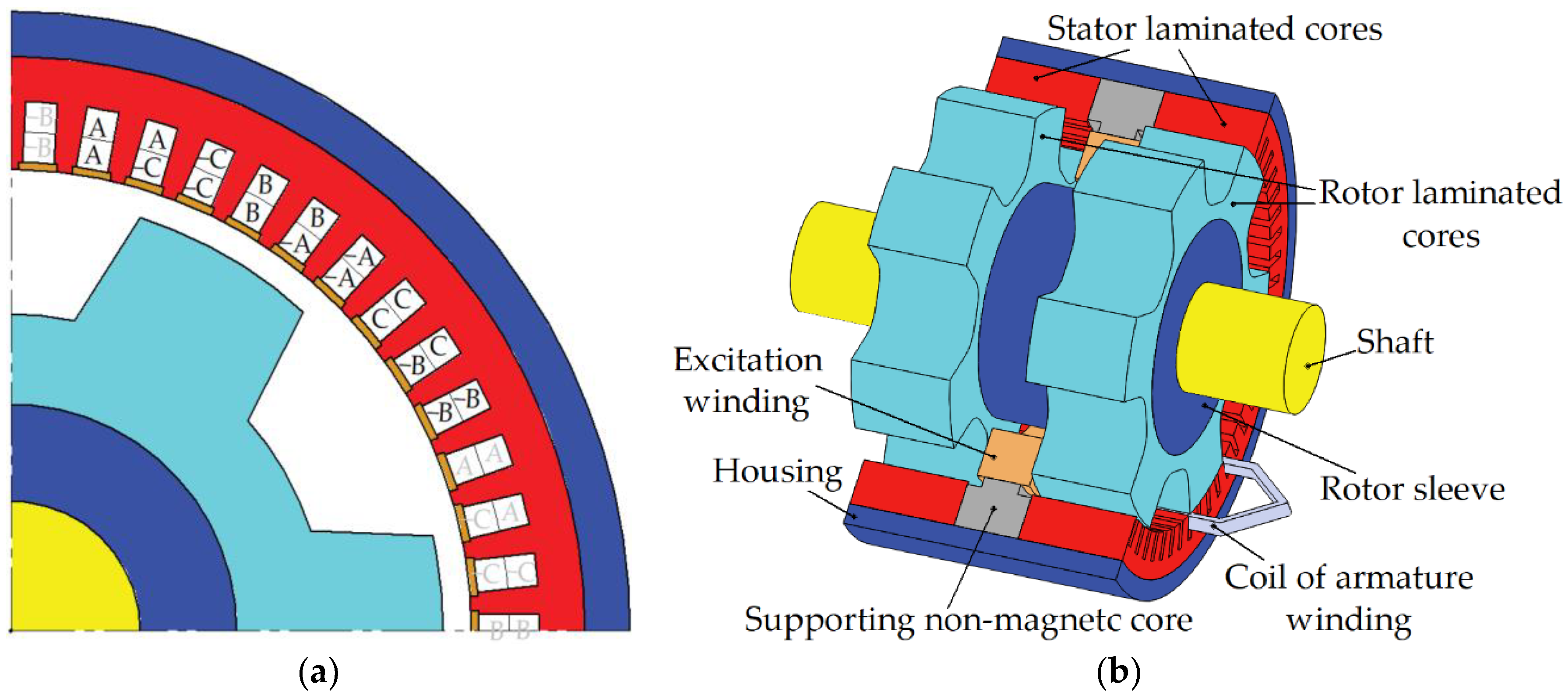
3. Operating Points of the Generator, Variable Geometric Parameters, and Objective Function
- Average losses <Ploss>, which were estimated as the average losses in the modes with the speeds of 750 rpm and 3450 rpm;
- Maximum value of the stator current Iarm (reached at 750 rpm mode);
- Maximum symmetrized torque ripple max(TRsym) in both modes;
- Maximum nonsymmetrized torque max(TR) in both modes.
| Parameter | Value |
|---|---|
| Machine length without end winding parts L, mm | 180 |
| Stator housing outer diameter, mm | 370 |
| Axial clearance between excitation winding and rotor, Δa, mm | 15 |
| Radial clearance between field winding and rotor Δr, mm | 12 |
| Shaft diameter, mm | 40 |
| Stator lamination yoke Hstator yoke, mm | 12 |
| Rotor lamination yoke Hrotor yoke, mm | 9 |
| Stator wedge thickness, ε2, mm | 1 |
| Stator unfilled area thickness, ε1, mm | 1 |
| Angle of field weakening at 750 rpm, el. degrees | 0.1 |
| Laminated steel grade | 2412 |
| Laminated steel thickness, mm | 0.35 |
| Parameter | Initial Design, x0 | Optimized Design, x |
|---|---|---|
| Stator housing thickness h, mm | 15 | 17.1 |
| Total stator stack length Lstator, mm | 150 | 152.7 |
| Stator slot depth, hp, mm | 20 | 29.8 |
| Stator slot width, bp, mm | 5 | 5.6 |
| Airgap width δ, mm | 2 | 0.88 |
| Rotor slot thickness, α1 | 0.5 ∙ tz * | 0.554 ∙ tz * |
| Rotor slot thickness, α2 | 0.6 | 0.665 |
| Angle of field weakening at 3450 rpm, electrical radian | 0.6 | 1.13 |
| Current ratio ** | 8 | 6.43 |
4. Optimization Results
- (1)
- The losses in operating point 2 reduce by 100% (11.56 − 8.10)/11.56 = 30%;
- (2)
- The losses in operating point 1 are much lower than those in point 2, and their increase by 3.84/2.52 = 1.5 times is not so bad. In addition, it is the price for the reduction in the required rectifier power by 100% (100.6 − 67.9)/100.6 = 32.5%, which is achieved by increasing the field weakening angle;
- (3)
- However, average losses reduce by 100% (7.04 − 5.97)/7.04 = 15.2%;
- (4)
- To demonstrate the ability of the SHG to produce energy at a speed lower than 750 rpm, the 300 rpm mode was calculated. To reduce saturation and losses, the torque equal to 90% of the torque in point 2 was chosen. The output power is 8.03 kW; the input power is 14.42 kW, and the generator efficiency is 56%;
- (5)
- After optimization, the maximum symmetrized torque ripple (ripple at the shaft at low speed was reduced by 100% (13.1 − 11.3)/13.1 = 13.7%;
- (6)
- Comparison of the initial and the optimized designs shows that as a result of optimization, the area of the stator slots for the winding increased by increasing the height and reducing the thickness of the stator tooth, which leads to a decrease in the armature winding resistance and the DC losses in the winding.
| Parameter | Initial Design | Optimized Design | ||
|---|---|---|---|---|
| Operating point | 1 | 2 | 1 | 2 |
| Rotational speed n, rpm | 3450 | 750 | 3450 | 750 |
| Amplitude of the armature phase current Iarm, A | 388.6 | 1001.7 | 369.5 | 676.2 |
| Efficiency η *, % | 93.7 | 71.1 | 90.4 | 79.8 |
| Input mechanical power Pmech, kW | 40 | 40 | 40 | 40 |
| Active electrical power P1, kW | 37.67 | 29.33 | 36.58 | 33.12 |
| Output electrical power P1 − Pex, kW | 37.5 | 28.4 | 36.2 | 32.0 |
| Armature DC copper loss Parm DC, kW | 1.55 | 10.30 | 1.90 | 6.37 |
| Armature eddy current copper loss Parm AC, W | 123 | 51 | 417 | 131 |
| Stator lamination loss Piron st, W | 663 | 359 | 961 | 403 |
| Rotor lamination loss Piron rt, W | 51 | 10 | 192 | 26 |
| Excitation copper loss Pex, W | 129 | 837 | 368 | 1169 |
| Total loss Ploss **, kW | 2.52 | 11.56 | 3.84 | 8.10 |
| Average loss <Ploss>, kW | 7.04 | 5.97 | ||
| Number of turns in armature winding | 5.14 | 7.75 | ||
| Required rectifier power, kW | 100.6 | 67.9 | ||
| Power factor | 0.969 | 0.668 | 1.000 | 0.747 |
| Line-to-line voltage amplitude Varm, V | 116.0 | 51.3 | 116.0 | 75.3 |
| Nonsymmetrized torque ripple, % | 49.7 | 33.7 | 97.8 | 47.0 |
| Symmetrized torque ripple, % | 13.1 | 5.0 | 11.3 | 4.5 |
| Magnetic flux density in the housing and the sleeve Bh, T | 1.00 | 1.91 | 0.84 | 1.60 |
5. Performance Comparison of the Optimized Design with a Commercially Available Undercar Generator
- (1)
- The volume of the active part of the optimized SHG is 0.04/0.019 = 2.1 times smaller than that of a mass-produced generator. It is expected that the mass and the cost of the optimized SHG will be less than that of the mass-produced generator;
- (2)
- The calculated efficiency of the optimized SHG neglecting mechanical losses is much greater than the efficiency of the mass-produced SHG over the entire range of operation. The mechanical losses that are mainly small losses in the bearings cannot reduce the efficiency significantly;
- (3)
- The reduced input (mechanical) power due to the reduction of power loss of the SHG results in reducing the load on the transmission elements and wheels of the car, which will increase their lifetime.
6. Conclusions
Author Contributions
Funding
Institutional Review Board Statement
Informed Consent Statement
Data Availability Statement
Acknowledgments
Conflicts of Interest
References
- Percentage of the Railway Lines in Use in Europe in 2020 which Were Electrified, by Country. Report. Statista. 2023. Available online: https://www.statista.com/statistics/451522/share-of-the-rail-network-which-is-electrified-in-europe/ (accessed on 29 January 2023).
- Worldwide Rail Electrification Remains at High Volume. Press Release. RailwayPRO Communication Platform. 19 February. 2021. Available online: https://www.railwaypro.com/wp/worldwide-rail-electrification-remains-at-high-volume/ (accessed on 29 January 2023).
- Liudvinavičius, L.; Jastremskas, V. Modernization of diesel-electric locomotive 2M62 and TEP-70 locomotives with respect to electrical subsystem. Procedia Eng. 2017, 187, 272–280. [Google Scholar] [CrossRef]
- Levin, N.; Kamolins, E.; Pugachev, V.; Gusakov, A. Synchronous generator with two-channel excitation for power supply of railway passenger cars. In Proceedings of the 2012 Electric Power Quality and Supply Reliability, Tartu, Estonia, 11–13 June 2012; pp. 1–6. [Google Scholar] [CrossRef]
- Gulbis, K.; Kamolins, E.; Brakanskis, U. Synchronous inductor generator with electrically integrated armature and field windings with improved performance. In Proceedings of the IEEE 8th Workshop on Advances in Information, Electronic and Electrical Engineering (AIEEE), Vilnius, Lithuania, 22–24 April 2021; pp. 1–6. [Google Scholar] [CrossRef]
- Bindu, G.; Basheer, J.; Venugopal, A. Analysis and control of rotor eccentricity in a train-lighting alternator. In Proceedings of the IEEE International Conference on Power, Control, Signals and Instrumentation Engineering (ICPCSI), Chennai, India, 21–22 September 2017; pp. 2021–2025. [Google Scholar] [CrossRef]
- Lorilla, L.; Keim, T.; Lang, J.; Perreault, D. Topologies for future automotive generators: Part I—Modeling and analytics. In Proceedings of the 2005 IEEE Vehicle Power and Propulsion Conference, Chicago, IL, USA, 7 September 2005; pp. 74–85. [Google Scholar] [CrossRef]
- Bianchini, C.; Immovilli, F.; Bellini, A.; Lorenzani, E.; Concari, C.; Scolari, M. Homopolar generators: An overview. In Proceedings of the IEEE Energy Conversion Congress and Exposition, Phoenix, AZ, USA, 17–22 September 2011; pp. 1523–1527. [Google Scholar] [CrossRef]
- Dmitrievskii, V.; Prakht, V.; Anuchin, A.; Kazakbaev, V. Traction Synchronous Homopolar Motor: Simplified Computation Technique and Experimental Validation. IEEE Access 2020, 8, 185112–185120. [Google Scholar] [CrossRef]
- Severson, E.; Nilssen, R.; Undeland, T.; Mohan, N. Dual-purpose no-voltage winding design for the bearingless AC homopolar and consequent pole motors. IEEE Trans. Ind. Appl. 2015, 51, 2884–2895. [Google Scholar] [CrossRef]
- Jeong, J.-S.; An, D.-K.; Hong, J.-P.; Kim, H.-J.; Jo, Y.-S. Design of a 10-MW-Class HTS homopolar generator for wind turbines. IEEE Trans. Appl. Supercond. 2017, 27, 1–4. [Google Scholar] [CrossRef]
- Kutt, F.; Michna, M.; Kostro, G. Non-Salient Brushless Synchronous Generator Main Exciter Design for More Electric Aircraft. Energies 2020, 13, 2696. [Google Scholar] [CrossRef]
- Noeland, J.; Nuzzo, S.; Tessarolo, A.; Alves, E. Excitation System Technologies for Wound-Field Synchronous Machines: Survey of Solutions and Evolving Trends. IEEE Access 2019, 7, 109699–109718. [Google Scholar] [CrossRef]
- Prakht, V.; Dmitrievskii, V.; Kazakbaev, V.; Anuchin, A. Comparative Study of Electrically Excited Conventional and Homopolar Synchronous Motors for the Traction Drive of a Mining Dump Truck Operating in a Wide Speed Range in Field-Weakening Region. Mathematics 2022, 10, 3364. [Google Scholar] [CrossRef]
- Levin, N.; Kamolins, E.; Pugachev, V. Unlike-Pole Inductor Generator with Electrically Integrated Armature and Excitation Windings for the Power Supply Systems of Passenger Cars. Latv. J. Phys. Tech. Sci. 2013, 50, 12–23. [Google Scholar] [CrossRef]
- Ferrari, S.; Pellegrino, G. FEAfix: FEA Refinement of Design Equations for Synchronous Reluctance Machines. IEEE Trans. Ind. Appl. 2020, 56, 256–266. [Google Scholar] [CrossRef]
- Cheshmehbeigi, H.; Afjei, E. Design optimization of a homopolar salient-pole brushless DC machine: Analysis, simulation, and experimental tests. IEEE Trans. Energy Convers. 2013, 28, 289–297. [Google Scholar] [CrossRef]
- Severson, E.; Mohan, N.; Nilssen, R.; Undeland, T. Outer-rotor AC homopolar motors for flywheel energy storage. In Proceedings of the 7th IET International Conference on Power Electronics, Machines and Drives (PEMD), Manchester, UK, 8–10 April 2014; pp. 1–6. [Google Scholar] [CrossRef]
- Hwang, Y.J. Design and Characteristic Analysis of a Homopolar Synchronous Machine Using a NI HTS Field Coil. Energies 2021, 14, 5658. [Google Scholar] [CrossRef]
- Yang, J.; Ye, C.; Liang, X.; Xu, W.; Xiong, F.; Xiang, Y.; Li, W. Investigation of a Two-Dimensional Analytical Model of the Homopolar Inductor Alternator. IEEE Trans. Appl. Supercond. 2018, 28, 5205205. [Google Scholar] [CrossRef]
- Ye, C.; Yang, J.; Xiong, F.; Zhu, Z.Q. Relationship between homopolar inductor machine and wound-field synchronous machine. IEEE Trans. Ind. Electron. 2020, 67, 919–930. [Google Scholar] [CrossRef]
- Belalahy, C.; Rasoanarivo, I.; Sargos, F. Using 3D reluctance network for design a three phase synchronous homopolar machine. In Proceedings of the 34th Annual Conference of IEEE Industrial Electronics, Orlando, FL, USA, 10–13 November 2008; pp. 2067–2072. [Google Scholar] [CrossRef]
- Dmitrievskii, V.; Prakht, V.; Anuchin, A.; Kazakbaev, V. Design Optimization of a Traction Synchronous Homopolar Motor. Mathematics 2021, 9, 1352. [Google Scholar] [CrossRef]
- Prakht, V.; Dmitrievskii, V.; Anuchin, A.; Kazakbaev, V. Inverter Volt-Ampere Capacity Reduction by Optimization of the Traction Synchronous Homopolar Motor. Mathematics 2021, 9, 2859. [Google Scholar] [CrossRef]
- Dmitrievskii, V.; Prakht, V.; Kazakbaev, V.; Anuchin, A. Design Optimization of the Magnet-Free Synchronous Homopolar Motor of a Subway Train. Appl. Sci. 2022, 12, 12647. [Google Scholar] [CrossRef]
- Dmitrievskii, V.; Prakht, V.; Kazakbaev, V.; Anuchin, A. Comparison of Interior Permanent Magnet and Synchronous Homopolar Motors for a Mining Dump Truck Traction Drive Operated in Wide Constant Power Speed Range. Mathematics 2022, 10, 1581. [Google Scholar] [CrossRef]
- Lashkevich, M.; Anuchin, A.; Aliamkin, D.; Briz, F. Control strategy for synchronous homopolar motor in traction applications. In Proceedings of the 43rd Annual Conference of the IEEE Industrial Electronics Society (IECON), Beijing, China, 29 October–1 November 2017; pp. 6607–6611. [Google Scholar] [CrossRef]
- Kalsi, S.; Hamilton, K.; Buckley, R.G.; Badcock, R.A. Superconducting AC Homopolar Machines for High-Speed Applications. Energies 2019, 12, 86. [Google Scholar] [CrossRef]
- Orlova, S.; Pugachov, V.; Levin, N. Hybrid Excitation of the Axial Inductor Machine. Latv. J. Phys. Tech. Sci. 2012, 49, 35–41. [Google Scholar] [CrossRef]
- Janis, D.; Levin, N.; Orlova, S.; Pugachov, V.; Ribickis, L. Optimization of the magnetic circuit of an axial inductor machine based on the calculation and analysis of magnetic field. In Proceedings of the 13th European Conference on Power Electronics and Applications, Barcelona, Spain, 8–10 September 2009; pp. 1–8. Available online: https://ieeexplore.ieee.org/document/5278726 (accessed on 29 January 2023).
- Synchronous Generators Type EGV. The Generators EGV Are Designed for Power Supply of a Passenger Car. Characteristics. Pskov Electric Machine-Building Plant. Available online: https://www.pemz.ru/catalog/dlya_zheleznoy_dorogi/Synchronous_generators_type_EGV/ (accessed on 30 January 2023).
- Guo, S.; Yi, Z.; Liu, P.; Wang, G.; Lai, H.; Yu, K.; Xie, X. Analysis and Performance Evaluation of a Novel Adjustable Speed Drive with a Homopolar-Type Rotor. Mathematics 2022, 10, 3712. [Google Scholar] [CrossRef]
- IEC 60317-0-2:2020; Specifications for Particular Types of Winding Wires—Part 0-2: General Requirements—Enamelled Rectangular Copper Wire. IEC: Geneva, Switzerland, 2020. Available online: https://webstore.iec.ch/publication/63495 (accessed on 30 January 2023).
- Lagarias, J.; Reeds, J.; Wright, M.; Wright, P. Convergence Properties of the Nelder-Mead Simplex Method in Low Dimensions. SIAM J. Optim. 1998, 9, 112–147. [Google Scholar] [CrossRef]
- Find Minimum of Unconstrained Multivariable Function Using Derivative-Free Method. MATLAB Documentation. ©1994–2023 The MathWorks, Inc. Available online: https://www.mathworks.com/help/matlab/ref/fminsearch.html (accessed on 30 January 2023).
- Ponkratov, Y. Electric Machines of Railway Cars; Educational and Methodological Center for Education in Railway Transport: Moscow, Russia, 2016; Available online: https://studref.com/552936/tehnika/konstruktsii_mashin_peremennogo_toka (accessed on 30 January 2023). (In Russian)
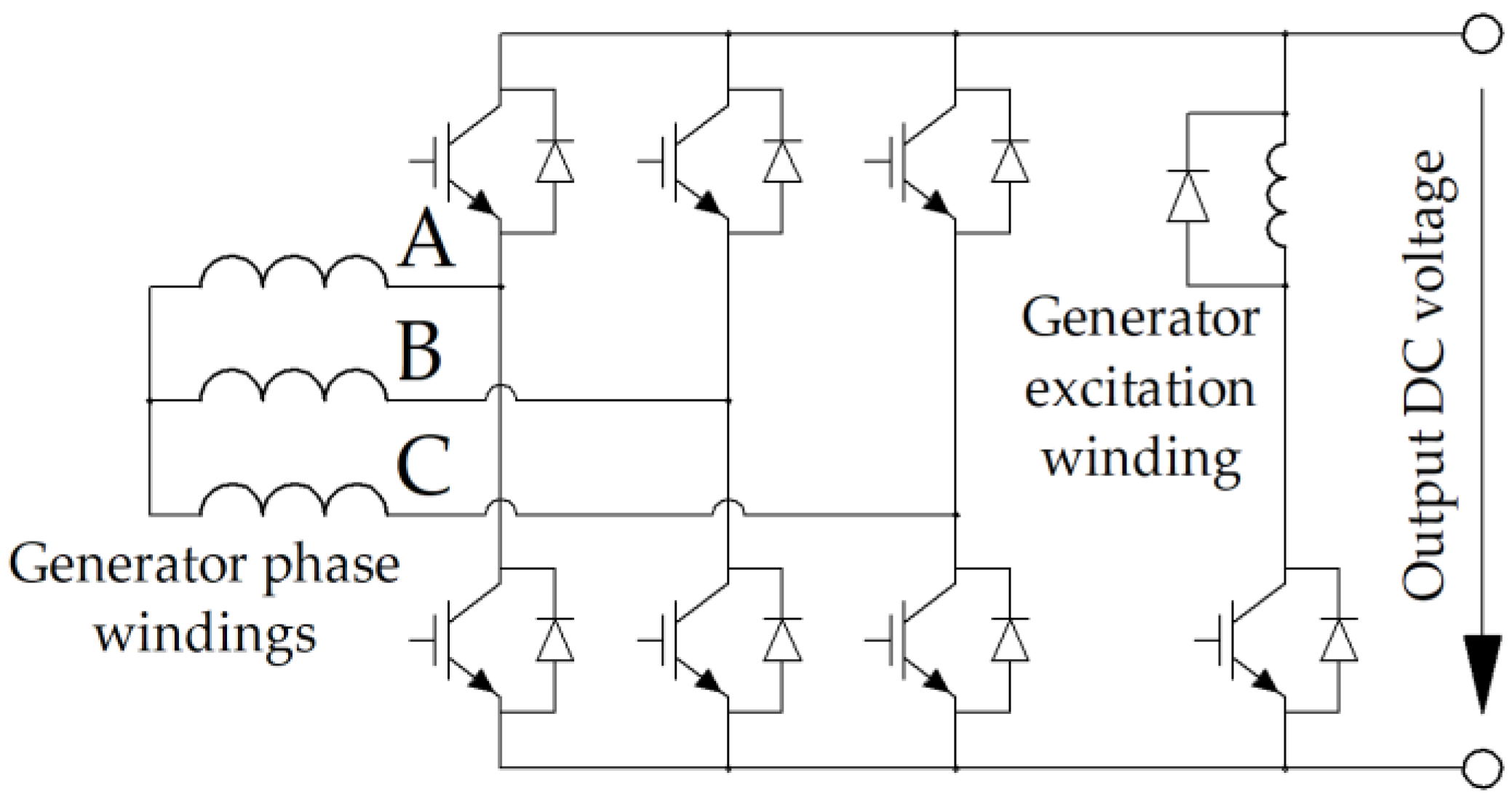
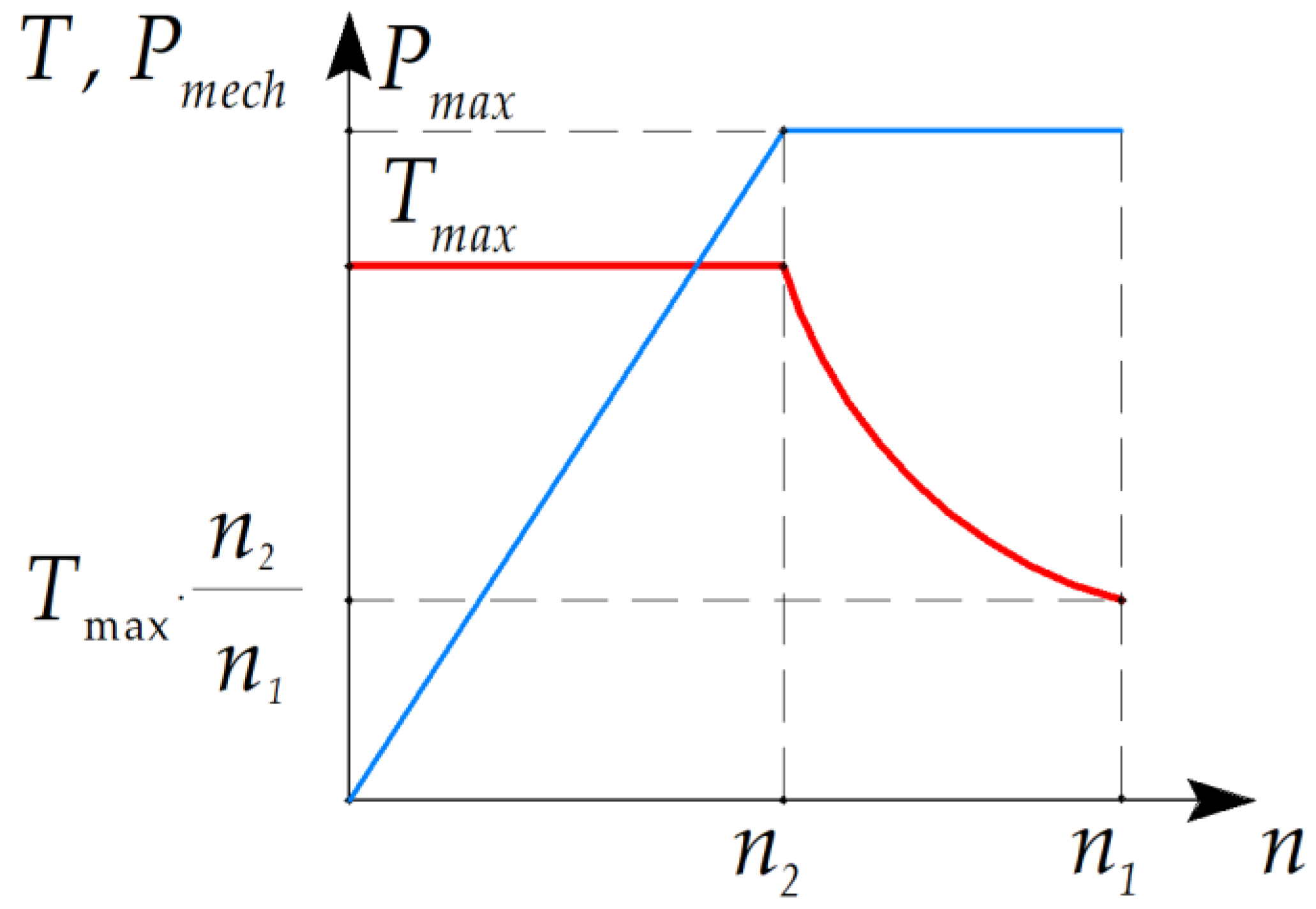
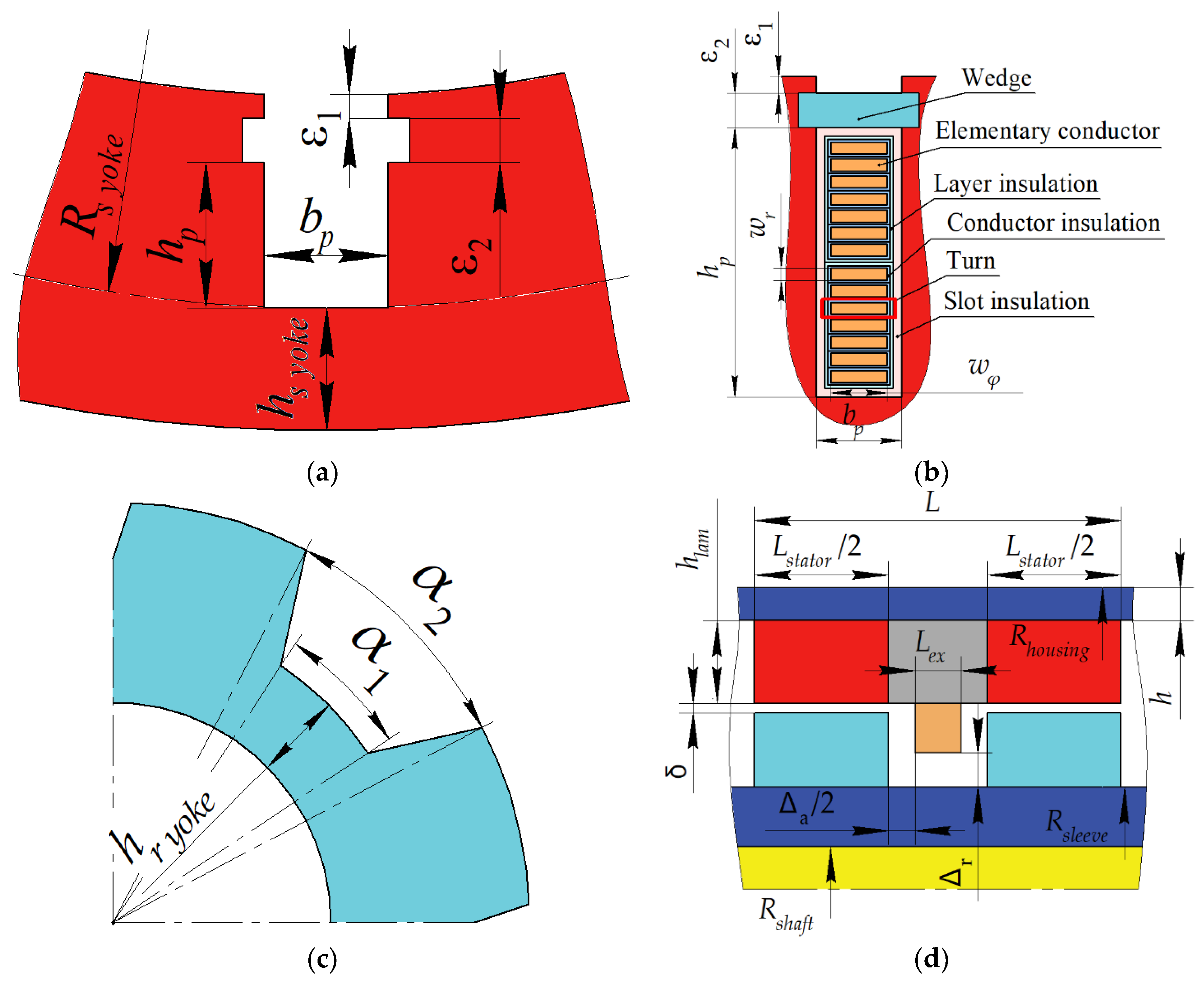

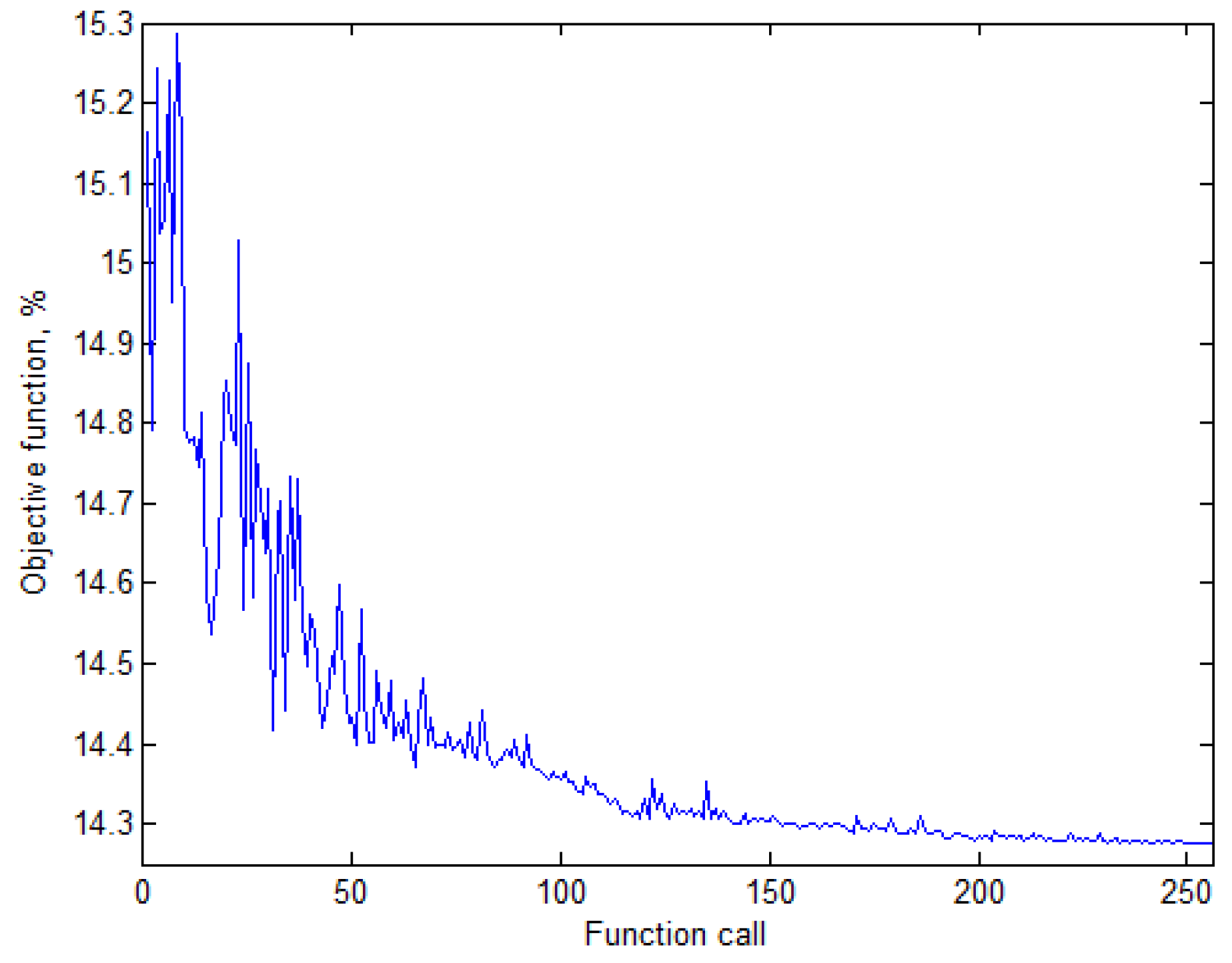

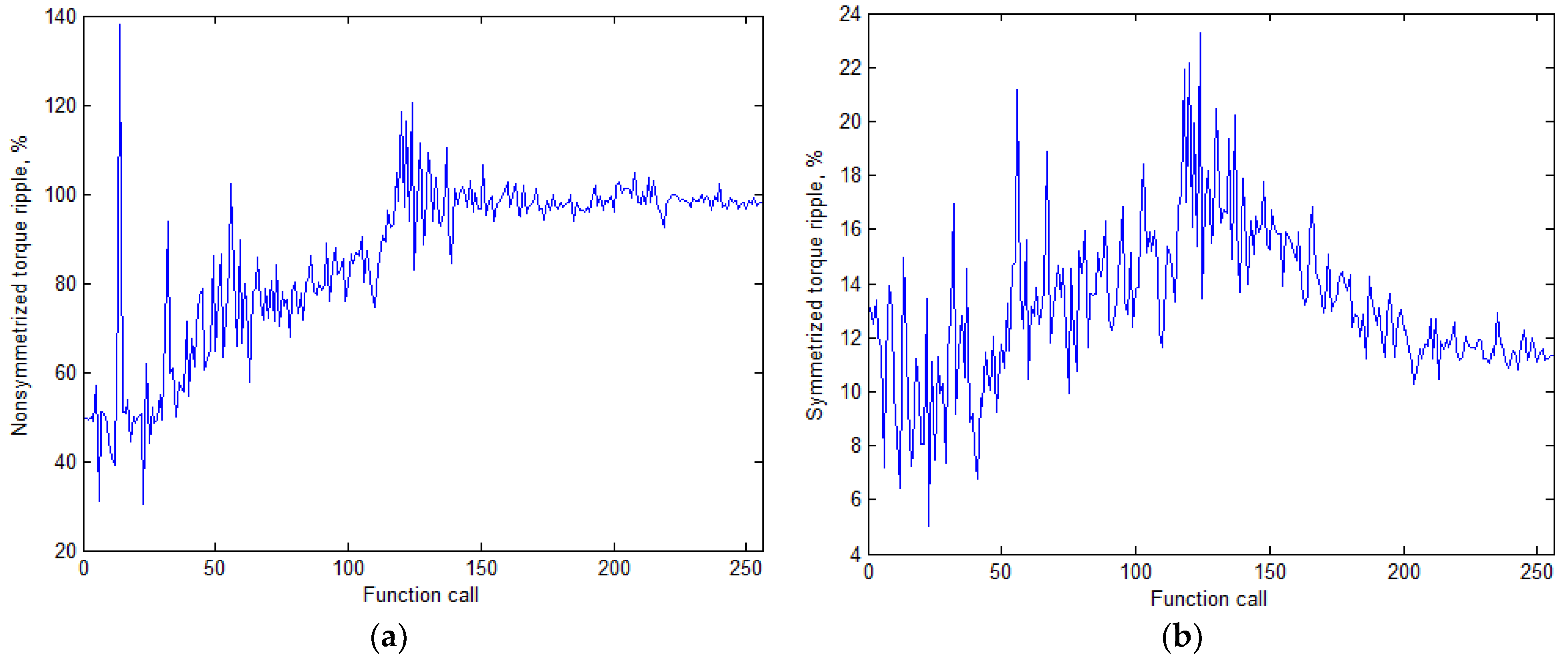
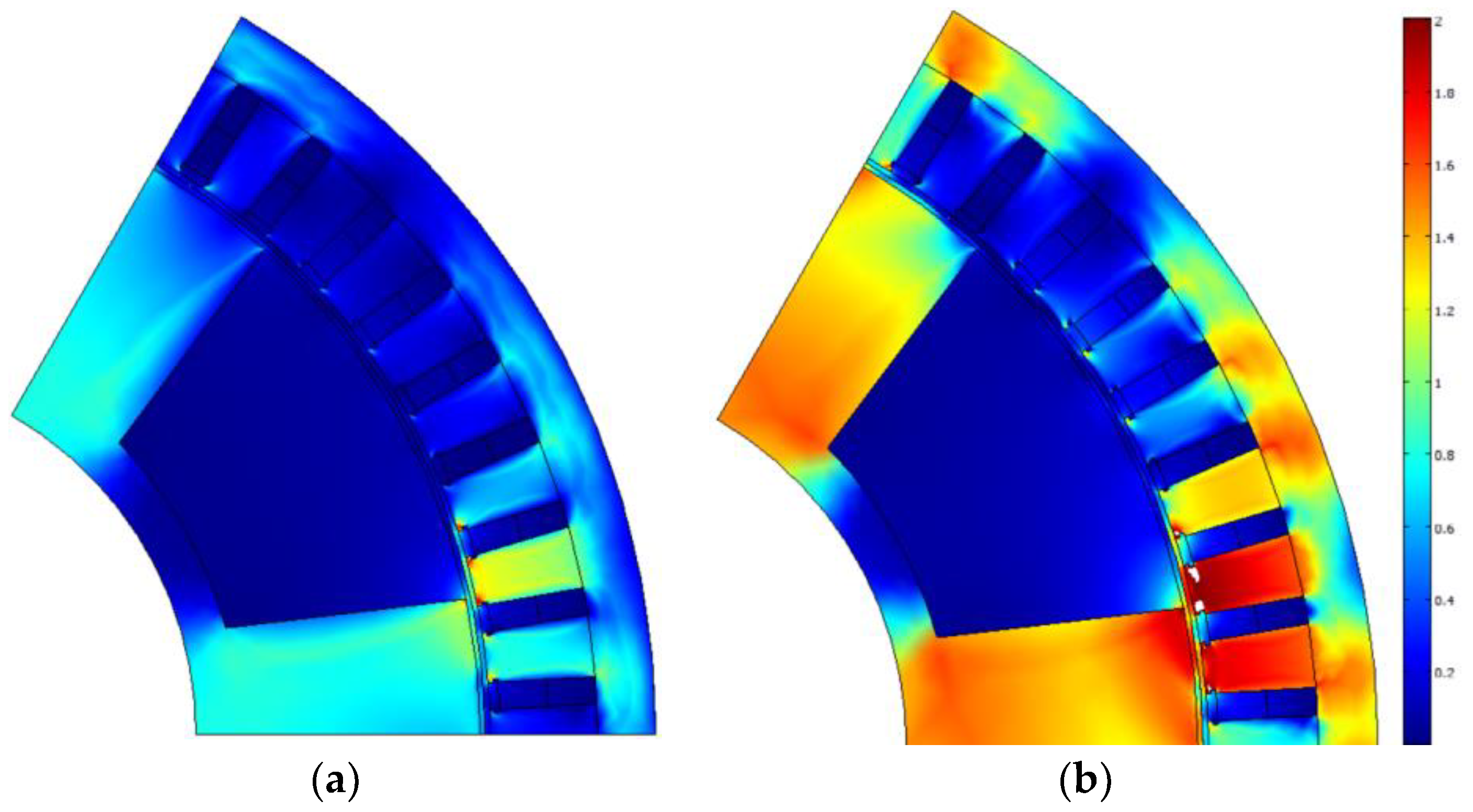
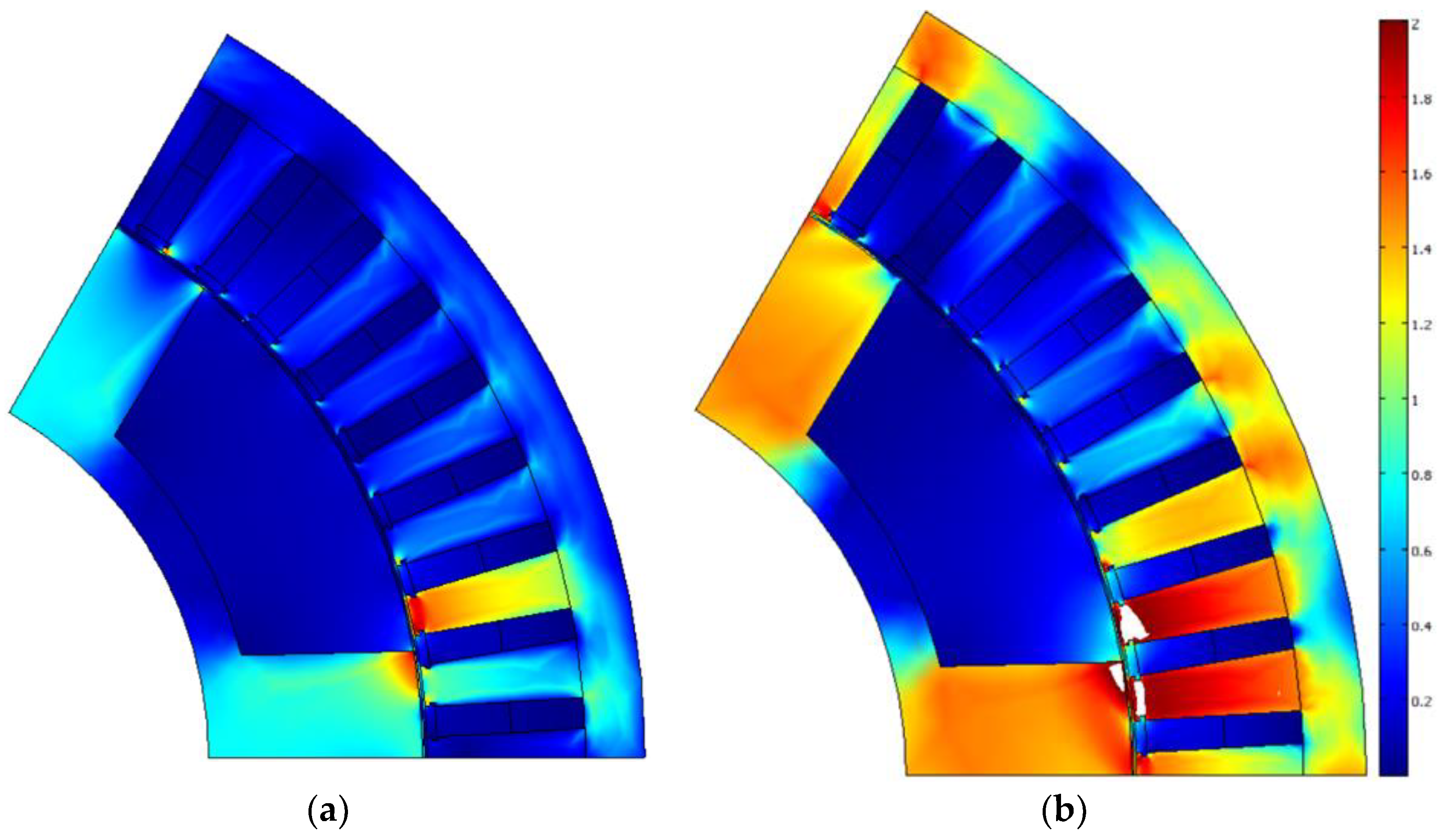
| Parameter | EGV.08.1 (PEMZ) [31] | Optimized Design of the SHG |
|---|---|---|
| Output electric power, kW | 35 | ≈35 (36.2 kW at 3500 rpm; 32.0 kW at 800 rpm) |
| Average output power, kW | 35 | 34.1 |
| Number of poles | 24 | 12 |
| Electric frequency at maximum speed, Hz | 690 | 350 |
| Stator outer diameter (excluding cooling fins) D, mm | 380 | 370 |
| Machine length without end winding parts L, mm | 357 * | 180 |
| Active parts volume π∙L∙D2/4, m3 | 0.04 | 0.019 |
| Efficiency @ 750 rpm % | 72 | 79.8 (without taking into account mechanical losses) |
| Efficiency @ 3450 rpm, % | 85 | 90.4 (without taking into account mechanical losses) |
| Number of phases | 3 | 3 |
| Cooling type | Air cooling without fan | Air cooling without fan |
Disclaimer/Publisher’s Note: The statements, opinions and data contained in all publications are solely those of the individual author(s) and contributor(s) and not of MDPI and/or the editor(s). MDPI and/or the editor(s) disclaim responsibility for any injury to people or property resulting from any ideas, methods, instructions or products referred to in the content. |
© 2023 by the authors. Licensee MDPI, Basel, Switzerland. This article is an open access article distributed under the terms and conditions of the Creative Commons Attribution (CC BY) license (https://creativecommons.org/licenses/by/4.0/).
Share and Cite
Prakht, V.; Dmitrievskii, V.; Kazakbaev, V. Synchronous Homopolar Generator without Permanent Magnets for Railway Passenger Cars. Appl. Sci. 2023, 13, 2070. https://doi.org/10.3390/app13042070
Prakht V, Dmitrievskii V, Kazakbaev V. Synchronous Homopolar Generator without Permanent Magnets for Railway Passenger Cars. Applied Sciences. 2023; 13(4):2070. https://doi.org/10.3390/app13042070
Chicago/Turabian StylePrakht, Vladimir, Vladimir Dmitrievskii, and Vadim Kazakbaev. 2023. "Synchronous Homopolar Generator without Permanent Magnets for Railway Passenger Cars" Applied Sciences 13, no. 4: 2070. https://doi.org/10.3390/app13042070
APA StylePrakht, V., Dmitrievskii, V., & Kazakbaev, V. (2023). Synchronous Homopolar Generator without Permanent Magnets for Railway Passenger Cars. Applied Sciences, 13(4), 2070. https://doi.org/10.3390/app13042070









